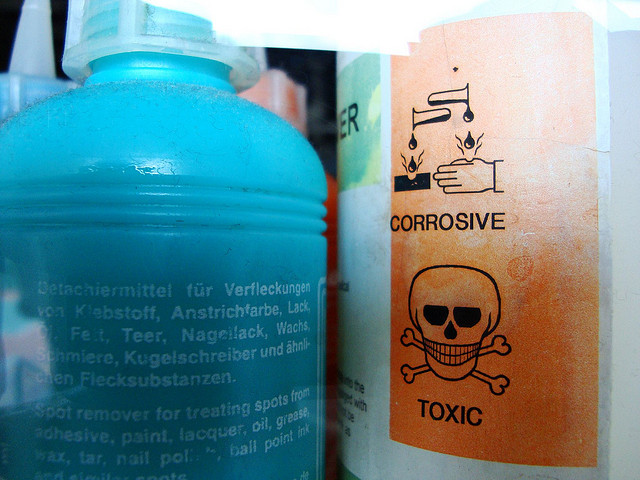Employers that have hazardous chemicals in their workplaces are required by OSHA’s Hazard Communication Standard (HCS), 29 CFR 1910.1200, to implement a hazard communication program. The program must include labels on containers of hazardous chemicals, safety data sheets (SDSs) for hazardous chemicals, and training for workers, and the employer must describe in a written program how it will meet the requirements of the HCS in each of these areas. Employers can implement an effective hazard communication program by following these six steps: learn the standard and identify responsible staff; prepare and implement a written hazard communication program; ensure containers are labeled; maintain Safety Data Sheets (SDSs); inform and train employees; and evaluate and reassess your program.
Audit, Compliance and Risk Blog
OSHA 29 CFR 1910.1200: A MUST for Employers That Use Hazardous Chemicals
Posted by STP Editorial Team on Mon, May 12, 2014
Tags: Business & Legal, Employer Best Practices, Health & Safety, Environmental risks, Environmental, EHS, Hazcom
Supreme Court Reinstates EPA Interstate Regulation of Upwind Air Emissions
Posted by Jon Elliott on Wed, May 07, 2014
On April 29 the US Supreme Court reversed a lower court decision, reinstating US Environmental Protection Agency (EPA) rules requiring states to control emissions of air pollutants that contaminate downwind states (EPA v. EME Homer City Generation, LP). The Cross-State Air Pollution Rule (CASPR, or the “Transport Rule”) implements “Good Neighbor” provisions in the Clean Air Act (CAA) designed to ensure that upwind states’ emissions don’t prevent a downwind state from meeting air quality standards. This ruling frees EPA to implement rules requiring tighter emission controls on pollutant sources in upwind states.
Tags: Business & Legal, Health & Safety, Environmental risks, Environmental, EHS, climate change, Transportation
EU Parliament To Require Corporate Social Responsibility and Diversity Reporting
Posted by Jon Elliott on Mon, May 05, 2014
On April 15, the European Parliament adopted a proposal to expand public company requirements to report accounting information, adding social responsibility and diversity reporting for companies that meet specified employee and revenue thresholds. The new directive provides targeted companies with flexibility to meet these rules by meeting national or voluntary standards that require at least equivalent reporting. To become law, the Commission's proposal must also be adopted by the European Union (EU) Member States in the Council (which votes by qualified majority); this is anticipated within the coming weeks.
Tags: Corporate Governance, Business & Legal, Employer Best Practices, International, Environmental risks, Environmental, EHS
News from The Bureau of Safety and Environmental Enforcement (BSEE) Press Release Issued April 3, 2014
Tags: Corporate Governance, Business & Legal, SEC, OSHA, Environmental risks, Environmental, EHS, Oil & Gas, climate change
On April 11, the D.C. Circuit Court of Appeals denied a petition by SeaWorld, which was seeking to overturn a citation and penalty issued by the Occupational Safety and Health Administration (OSHA) after a killer whale mauled and drowned one of the park’s trainers during a show (Seaworld of Florida, LLC v. Perez). OSHA had cited SeaWorld for violating the OSH Act’s Employer’s General Duty Clause, by failing to provide a workplace free of “free from recognized hazards that are causing or are likely to cause death or serious physical harm.” This decision reminds us that this often-neglected element of OSH compliance serves important worker safety goals.
Tags: Business & Legal, Employer Best Practices, Health & Safety, OSHA, Employee Rights, Environmental risks, EHS
Workers’ Compensation in California: What If You Get Hurt on the Job?
Posted by STP Editorial Team on Mon, Apr 14, 2014
The workers’ compensation system is based on a trade-off between employers and employees. Employees are entitled to receive prompt, effective medical treatment for on-the-job injuries or illnesses no matter who is at fault and, in return, are therefore prevented from suing employers over those injuries. As a result, California employers, as in other states, are required by law to have workers’ compensation insurance, even if they have only one employee. And, if employees get hurt or sick because of work, the employer is required to pay for workers’ compensation benefits. Workers’ comp insurance provides six basic benefits: medical care, temporary disability benefits, permanent disability benefits, supplemental job displacement benefits, or vocational rehabilitation and death benefits.
Tags: Corporate Governance, Business & Legal, Employer Best Practices, Health & Safety, Employee Rights, California Legislation, EHS, Disability benefits
EPA and Corps of Engineers Redefining “Waters of the United States”
Posted by Jon Elliott on Wed, Apr 09, 2014
The Clean Water Act (CWA) provides federal agencies with authority to regulate a wide range of activities that may affect “waters of the United States”—sometimes called “navigable waters.” These activities include water quality planning and discharge regulation by the US Environmental Protection Agency (EPA) and delegated states, and regulation of projects that may lead to “dredge and fill” of waters, through permits issued by the US Army Corps of Engineers.
Tags: Business & Legal, Environmental risks, Environmental, EHS, EPA, Underground Storage Tanks, effluent, Stormwater
Continual Improvement of ISO 14001 Environmental Management Systems
Posted by Allison Campbell on Mon, Apr 07, 2014
Continual Improvement is an important aspect of any EMS and ISO 14001 references it in five separate clauses. To fully benefit from it, it’s not enough to implement a system based on ISO 14001, or even to have your EMS certified as ISO 14001-compliant—you must monitor and maintain your system, and find ways to improve to it. Similarly, the International Organization for Standardization (ISO) reviews and revises its standards in an ongoing effort to improve relevance and effectiveness. ISO 14001:2004 is currently undergoing review, with some big changes expected in the new version due in mid-2015.
Tags: Corporate Governance, Business & Legal, Environmental risks, Environmental, EHS
Environmental Compliance: Santa Barbara Yearly Regulatory Measures
Posted by STP Editorial Team on Mon, Mar 31, 2014
State law requires the Santa Barbara County Air Pollution Control District to publish a list each year of regulatory measures that may be considered for adoption or amendment during the upcoming calendar year. The District posted its list for 2014 on January 5, 2014, which can be seen below. Before adopting or amending any regulation, the District publishes a notice in a local newspaper and holds a hearing to accept comments from affected businesses and other interested parties.
Tags: Health & Safety, California Legislation, Environmental risks, Environmental, EHS, Greenhouse Gas, ghg, mact, Santa Barbara
U.S. Transportation Safety—A Drug and Alcohol Clearinghouse?
Posted by STP Editorial Team on Wed, Mar 26, 2014
In an effort to reduce “significant risk to public safety,” the U.S. Department of Transportation (DOT) now proposes to establish a new Commercial Driver’s License Drug and Alcohol Clearinghouse for drug and alcohol test results for drivers operating under a commercial driver’s license (CDL). The clearinghouse would also track traffic citations for driving while under the influence of alcohol or drugs (DUIs).
Tags: Business & Legal, Employer Best Practices, Health & Safety, Employee Rights, Training, EHS, Transportation










